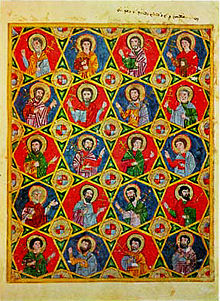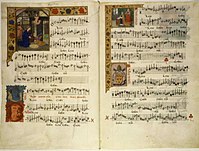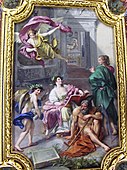Collections[edit]
While the Vatican Library has always included Bibles, canon law texts
and theological works, it specialized in secular books from the
beginning. Its collection of Greek and Latin classics was at the center
of the revival of classical culture during the Renaissance age.[7] The oldest documents in the library date back to the first century.[13]
The library was founded primarily as a manuscript library, a fact
reflected in the comparatively high ratio of manuscripts to printed
works in its collection. Such printed books as have made their way into
the collection are intended solely to facilitate the study of the much
larger collection of manuscripts.[21]
The collection also includes 330,000 Greek, Roman, and papal coins and medals.[5]
Every year about 6,000 new books are acquired.[5]
The library was enriched by several bequests and acquisitions over the centuries.
In 1623, the hereditary Palatine Library of Heidelberg containing about 3,500 manuscripts was given to the Vatican by Maximilian I, Duke of Bavaria (who had just acquired it as booty in the Thirty Years' War) in thanks for the adroit political maneuvers of Pope Gregory XV that
had sustained him in his contests with Protestant candidates for the
electoral seat. A token 39 of the Heidelberg manuscripts were sent to Paris in 1797 and were returned to Heidelberg at the Peace of Paris in 1815, and a gift from Pope Pius VII of 852 others was made in 1816 to the University of Heidelberg, including the Codex Manesse. Aside from that, the Palatine Library remains in the Vatican Library to this day.
In 1657, the manuscripts of the Dukes of Urbino were acquired. In 1661, the Greek scholar Leo Allatius was made librarian.
Queen Christina of Sweden's important library (mostly amassed by her generals as booty from Habsburg Prague and German cities during the Thirty Years War) was bought by Pope Alexander VIII on
her death in 1689. It represented, for all practical purposes, the
entire royal library of Sweden at the time. If it had remained where it
was in Stockholm, it would all have been lost in the destruction of the royal palace by fire in 1697.
Among the most famous holdings of the library is the Codex Vaticanus Graecus 1209, the oldest known nearly complete manuscript of the Bible. The Secret History of Procopius was discovered in the library and published in 1623.
Pope Clement XI sent scholars into the Orient to bring back manuscripts, and is generally accepted as the founder of the Oriental section.[6]
A School of Library Science is associated with the Vatican Library.
In 1959, a Film Library was established.[22] This is not to be confused with the Vatican Film Library, which was established in 1953 at Saint Louis University in St. Louis, Missouri.
The Library has a large collection of texts related to Hinduism, with the oldest editions dating to 1819.[23]
During the library's restoration between 2007 and 2010, all of the 70,000 volumes in the library were tagged with electronic chips to prevent theft.[16]
Manuscripts[edit]
Main page: Category:Manuscripts of the Vatican Library
Notable manuscripts in the Library include: Illuminated manuscripts:
Manuscripts relating to Christianity[edit]
- Barberini Gospels
- Gelasian Sacramentary, one of the oldest books on Christian liturgy
- Joshua Roll
- Lorsch Gospels, an illuminated gospel book written and illustrated from 778 to 820, which is spread up between various museums. The carved ivory rear cover and the Gospels of Luke and John are kept in the Vatican Library.
- Menologion of Basil II[24]
- Vatican Croatian Prayer Book
- Vergilius Vaticanus
Classic Greek and Latin texts[edit]
- Vergilius Romanus, Vergil's Aeneid
- Codex Vaticanus Latinus 3868, a 9th-century facsimile of Terence's comedies[25]
- Parts of Euclid's elements, most notable Book I, Proposition 47, one of the oldest Greek texts on the Pythagorean Theorem[1]
Others[edit]
- Codex Borgia, a mesoamerican ritual and divinatory manuscript made of animal skins
- Codex Vat. Arabo 368, the sole manuscript of the Hadith Bayad wa Riyad, an Arabic love story[26]
- Codex Vaticanus 3738, the Codex Ríos,[27] an accordion folded Italian translation of a Spanish colonial-era manuscript, with copies of the Aztec paintings from the original Codex Telleriano-Remensis, believed to be written by the Dominican friar Ríos in 1566.
- De arte venandi cum avibus, a Latin treatise on falconry in the format of a two-column parchment codex of 111 folios written in the 1240s.
Texts:
- Codex Vaticanus Latinus 3256, four leaves of the Vergilius Augusteus[28]
- Codex Vaticano Rossi 215, fragments of the Rossi Codex[29]
- Codex Vaticanus Graecus 1209, one of the oldest extant Bibles in Greek language
- Libri Carolini
- Vaticanus Graecus 1001, the original manuscript of the Secret History[30]
- One fragment of Heliand and three fragments of the Old Saxon Genesis comprise the Palatinus Latinus 1447.[31]
Digitization projects[edit]
In 2012, plans were announced to digitize, in collaboration with the Bodleian Library, a million pages of material from the Vatican Library. A grant was provided by the London-based Polonsky Foundation.[32]
On 20 March 2014, the Holy See announced that NTT Data Corporation and the Library concluded an agreement to digitize approximately 3,000 of the Library's manuscripts within four years.[33] NTT is donating the equipment and technicians, in an estimated to be worth 18 million Euros.[34] It
noted that there is the possibility of subsequently digitizing another
79,000 of the Library's holdings. These will be high-definition images
available on the Library's Internet site. Storage for the holdings will
be on a three petabyte server provided by EMC.[35] It is expected that the initial phase will take 4 years.[36]
The scanning of documents is impacted by the material used to product
the texts. Books using gold and silver in the illuminations require
special scanning equipment.[20] Digital copies are being stored in the CIFS file format.[13]
Gallery of holdings[edit]
Related libraries[edit]
Vatican Secret Library[edit]
Main article: Vatican Secret Archives
The Vatican Secret Archives, located in Vatican City, is the central archives for all of the acts promulgated by the Holy See, as well as the state papers, correspondence, papal account books,[37] and many other documents which the church has accumulated over the centuries. In the 17th century, under the orders of Pope Paul V,
the Secret Archives were separated from the Vatican Library, where
scholars had some very limited access to them, and remained absolutely
closed to outsiders until 1881, when Pope Leo XIII opened them to researchers, more than a thousand of whom now examine its documents each year.[38]
Vatican Film Library[edit]
Main article: Vatican Film Library
The Vatican Film Library in St. Louis, Missouri is the only collection, outside the Vatican itself, of microfilms of more than 37,000 works from the Biblioteca Apostolica Vaticana, the Vatican Library in Europe. It is located in the Pius XII Library on the campus of Saint Louis University.[39] The Library was created by Lowrie J. Daly (1914–2000), with funding from the Knights of Columbus.[40] The goal was to make Vatican and other documents more available to researchers in North America.[41]
Microfilming of Vatican manuscripts began in 1951, and according to the
Library's website, was the largest microfilming project that had been
undertaken up to that date.[42] The
Library opened in 1953, and moved to the St. Louis University campus,
in the Pius XII Memorial Library, in 1959. The first librarian was
Charles J. Ermatinger, who served until 2000. As of 2007, the Library
has microfilmed versions of over 37,000 manuscripts, with material in Greek, Latin, Arabic, Hebrew and Ethiopic,
as well as several more common Western European languages. There are
reproductions of many works from the Biblioteca Palatina and Biblioteca
Cicognara at the Vatican, as well as Papal letter registers from the Archivio Segreto Vaticano (Vatican Secret Archives) from the 9th to 16th centuries, in the series Registra Vaticana and Registra Supplicationium.[2]
Staff[edit]
Originally the director of the library was appointed a Cardinal, and given the title Cardinal Librarian.[6] Individual library staff were called "Custodians".[6] After the reopening of the library in 1883, Pope Leo XIII declared that the Cardinal Librarian be regarded as a Prefect.[6]
The Cardinal Librarian and Archivist of the Holy Roman Church is assisted by two prelates,
who are the Prefect of the Vatican Apostolic Library (the everyday
manager of the Library), and the Prefect of the Vatican Secret Archives
(who handles the daily affairs of the Archives). They are each assisted
by a Vice-Prefect.
The office of Librarian of Vatican Library has been held at the same time as that of Archivist of Vatican Secret Archives since 1957.
The current Prefect of the Vatican Apostolic Library is Monsignor Cesare Pasini (who is also the Director of the Vatican School of Library Science). The Vice Prefect of the Vatican Apostolic Library is Doctor Ambrogio M. Piazzoni. The Prefect of the Vatican Secret Archives is a Barnabite Bishop by the name of Sergio Pagano. The Vice Prefect of the Vatican Secret Archives is Father Marcel Chappin, S.J. The Archives also is responsible for the Vatican School of Paleography.[43][44]
The library currently has 80 staff who work in five departments:
manuscripts and archival collections, printed books/drawings,
acquisitions/cataloguing, coin collections/museums and
restoration/photography.[5]











No comments:
Post a Comment